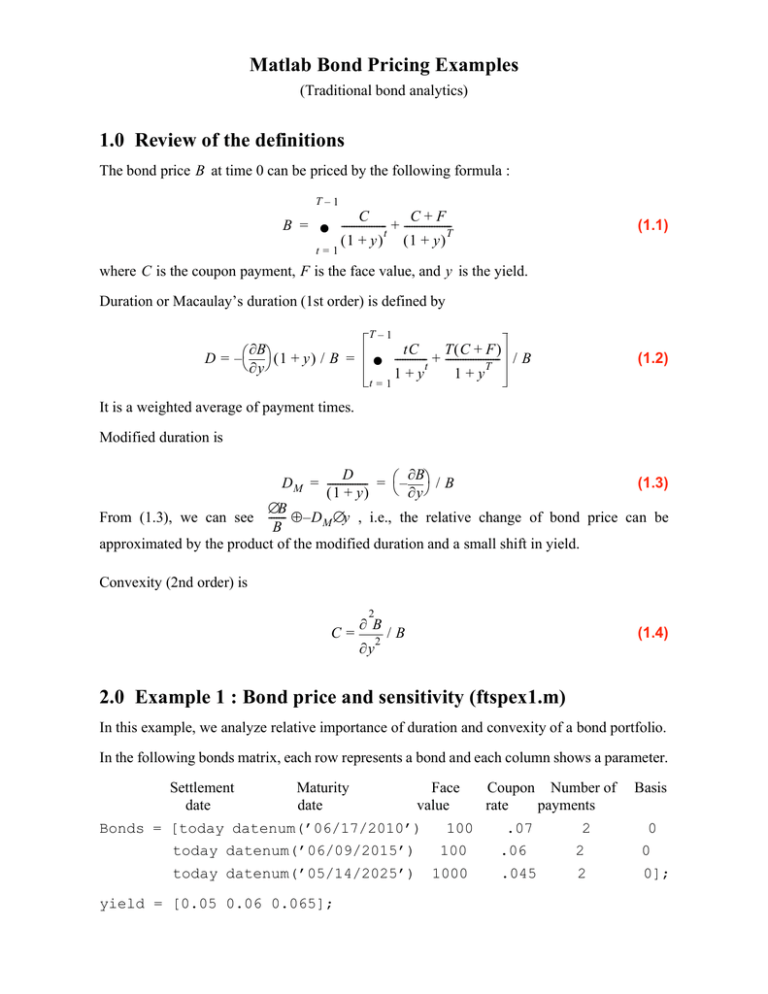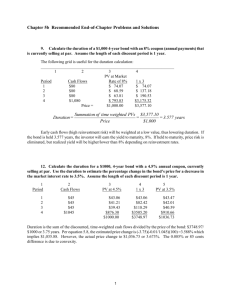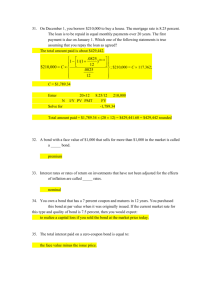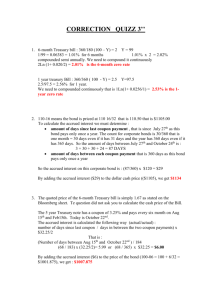∑ Matlab Bond Pricing Examples 1.0 Review of the definitions
advertisement

Matlab Bond Pricing Examples (Traditional bond analytics) 1.0 Review of the definitions The bond price B at time 0 can be priced by the following formula : T–1 B = C C+F -t + ------------------T∑ ----------------(1 + y ) (1 + y) (1.1) t=1 where C is the coupon payment, F is the face value, and y is the yield. Duration or Macaulay’s duration (1st order) is defined by ∂B D = – ( 1 + y ) / B = ∂y T–1 tC T(C + F ) -t + --------------------∑ -----------T 1+y 1+y /B (1.2) t=1 It is a weighted average of payment times. Modified duration is D ∂B D M = ---------------- = – / B (1.3) ( 1 + y) ∂y ∆B From (1.3), we can see ------- ≈ – D M ∆y , i.e., the relative change of bond price can be B approximated by the product of the modified duration and a small shift in yield. Convexity (2nd order) is 2 C= ∂B ∂y 2 /B (1.4) 2.0 Example 1 : Bond price and sensitivity (ftspex1.m) In this example, we analyze relative importance of duration and convexity of a bond portfolio. In the following bonds matrix, each row represents a bond and each column shows a parameter. Settlement Maturity Face Coupon Number of date date value rate payments Bonds = [today datenum(’06/17/2010’) 100 .07 2 today datenum(’06/09/2015’) 100 .06 2 today datenum(’05/14/2025’) 1000 .045 2 yield = [0.05 0.06 0.065]; Basis 0 0 0]; Coupon rate is nominal (annual) rate of coupon payments. prbond is a Matlab function which returns the price p and accrued interest ai of a bond given all the parameters. The syntax is [p, ai] = prbond(sd, md, rv, cpn, yld, per, basis) where sd is the settlement date, md is the maturity date, rv is the par value or face value, cpn is the coupon rate, yld is the yield, per is the number of coupon periods per year, and the basis is the day-count basis: 0 = actual/actual, 1 = 30/360, 2 = actual/360, 3 = actual/365. The coupon rate and number of coupon payments are used to calculate the amount of coupon C paid during each period. Accrued interest is determined by the following formula : settlement date – previous coupon date ai = C × ------------------------------------------------------------------------------------------------ time between periods (2.1) and the number of days in the numerator and denominator are measured differently according to the day-count basis. [d,m] = bonddur(sd, md, rv, cpn, yld, per, basis) finds the Macaulay duration d and modified duration m in years and [pc,yc] = bondconv(sd, md, rv, cpn, yld, per, basis) returns the convexity for a security in periods pc and years yc. The duration of the portfolio p_D M and convexity of the portfolio p_c can be calculated by the following formula. 3 p_D M = ∑ wi DM (i) and p_c 3 = i=1 ∑ wi yC (i) (2.2) i=1 where wi is the the weight of i-th bond in the portfolio and DM(i) and yC(i) are duration and convexity of i-th bond, respectively. Suppose there is a shift in yield curve, dY = .002, i.e., 20 basis points where 1 basis point is 1/100 percent or 1/10000. Percentage change of the portfolio price (linear approximation) is perc 1 = – p_D M * dY * 100 (2.3) and the second order approximation is 2 p_c * dY * 100 perc 2 = perc 1 + --------------------------------------2 (2.4) perc 1 * original price 1 = original + ------------------------------------100 (2.5) perc 2 * original and price 2 = original + ------------------------------------. 100 (2.6) The approximate prices are 3.0 Example 2 : Hedging against duration and convexity (ftspex2.m) This example constructs a bond portfolio to hedge the portfolio of example 1. We assume a long position in the portfolio in the example 1, and that three other bonds are available for hedging. We compute weights for these three other bonds in a new portfolio so that the duration and convexity of the new portfolio match those of the original portfolio. The following are the bonds we use in hedging : Settlement Maturity Face Coupon Number of date date value rate payments Bonds = [today datenum(’06/15/2005’) 500 .07 2 today datenum(’08/02/2010’) today datenum(’03/01/2025’) 1000 250 .066 .08 Basis 0 2 2 0 0]; yield = [0.06 0.07 0.075]; Step 1 : Compute the prices, modified durations - dur1, dur2, and dur3 -, and convexities - conv1, conv2, and conv3 - of the above bonds using Matlab functions prbond, bonddur, and bondconv, respectively. Step 2 : Get the weights of the bonds using the Matlab "\" operator. dur1 dur2 dur 3 A = conv conv conv and b = 1 2 3 1 1 1 p_D M p_c 1 (3.1) and the vector w of weights is w = A\b (3.2) 4.0 Example 3 : Visualizing the sensitivity of a bond portfolio’s price to parallel shifts in the yield curve (ftspex3.m) This example uses the Financial Toolbox bond pricing functions in a routine that takes time-tomaturity and yield as input arguments and returns the price of a portfolio of bonds. It plots the price and shows the behavior of bond prices as yield and time vary. 5.0 Yield curves and spot curves from bond data This example takes coupon bearing bonds with prices as input and generates the following four graphs. (1) Extracting yields Recall T–1 B = C C+F -t + ------------------T∑ ----------------(1 + y ) (1 + y) (5.1) t=1 The Matlab function yldbond returns yields when the bond prices are given. yldbond uses Newton’t method and cubin spline interpolation. (2) Spot rate (zero coupon yield curve) Use bootstrapping and smoothing with splines. Find each successive spot rate by requiring that the bond of the corresponding maturity be priced correctly, given all the previous rates calculated. This process is known as the "bootstrapp method" for calculating spot rates. (3) Extracting a forward rate curve from zero coupon yield curve Suppose y i and fi are the yield and the forward rate at the time T i respectively. The relation exp ( y i T i ) = exp ( y i – 1 T i – 1 ) exp ( f i [ T i – T i – 1 ] ) gives the formula for the forward rate. yi Ti – yi – 1 Ti – 1 fi = -------------------------------------Ti – Ti – 1 (5.2) 6.0 Portfolio Analysis : Heavy use of QPs and LPs Often finding the optimal portfolio is formulated as a QP. T min x Cx (6.1) T s.t. x r ≥ r∗ T x e = 1 C is a symmetric positive definite (SPD) matrix. The first constraint is for the expected profit. Variations (1) If no shorting is allowed, nonnegativity on x is required. (2) Sometimes there is a disjunctive constraint (much harder) : x i = 0 or x i ≥ l i > 0 (6.2) k T T min --- x Cx – r x 2 (6.3) (3) Risk aversion factor T x e = 1 where k is the risk tolerance. The objective function is called a utility function. (4) Downside minimization over scenarios T min E ( ( D x – τ )– ) expected gain over benchmark ≥ K (6.4) where y_ = min(0, y). The constraint is linear and the optimization problem can be formulates as LP. Solving positive definite QPs 1. The problem has a unique global solution. 2. Iterative solution i) Active set method : finite algorithm direct matrix factorization matrix updating e.g. - Matlab ( to change soon) - CPLEX ii) Asymptotic (usually interior) finds a sequence of points converging to the solution direct and indirect matrix solutions fast convergence driven by KT conditions








